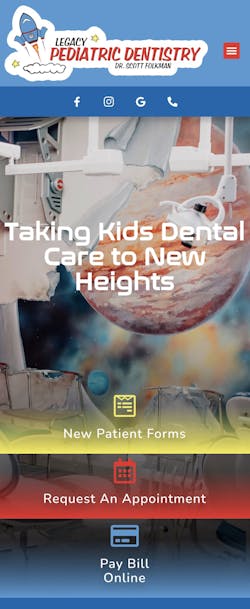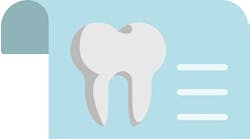Building a successful website for your dental practice is one of the most important things you can do to find new patients and keep existing patients around. But simply having a dental website isn’t enough. Websites for dentists need to be user friendly, and in today’s world, that means mobile friendly.
Mobile optimization for dental websites, either through responsive or adaptive design, is a crucial piece of the digital marketing puzzle. In this article we’ll discuss the two different types of dental website design, adaptive and responsive. By the end you’ll understand what’s best for your dental practice website.
What is mobile web design and why is it important?
Mobile web design refers to the coding of websites specifically for use on mobile devices like smartphones and tablets. Because mobile devices have smaller screens and no traditional mouse or keyboard, websites must look and function differently through mobile web design.
There are two main types of mobile optimization for dental websites: responsive design and adaptive design.
Responsive design
Responsive web design creates one template that adjusts in size depending on what device it’s shown on. Figure 1 shows an example website home page as viewed on a desktop browser. The responsive design of the same home page in Figure 2 is condensed, breaks banner text down into two lines, and swaps the menu bar for a hamburger menu.
Responsive design requires less work for the developer because they’re simply adjusting the size and tweaking a few details to make the website mobile friendly. Responsive design is a great option for mobile optimization because of its simplicity.
Adaptive design
In the context of dental websites, where the competition for online visibility is intense, the speed at which your website loads can be a game-changer. Search engines like Google prioritize faster-loading sites in their rankings because they offer a better user experience. This is where adaptive design comes into play.
Unlike responsive design, which rearranges the same webpage to fit different screen sizes, adaptive design has multiple versions of a web page, each specifically tailored for different devices. This means when a user accesses the site, only the version suitable for their device loads, eliminating unnecessary elements that slow down the loading time.
The direct result is a significantly faster website, which not only pleases visitors, but boosts your SEO efforts. In the dental industry, where first impressions are crucial, a fast-loading site can be the difference between a potential patient staying to explore your services or moving on to a competitor.
By choosing adaptive design, dental practices can ensure their website is not just esthetically pleasing and functional, but also ranks higher in search results, leading to increased visibility and patient acquisition.
When comparing the adaptive example in Figures 3 and 4 with the responsive example in Figures 1 and 2, you may not notice much difference.
Adaptive design is the gold standard, still found throughout the web on sites like YouTube and LinkedIn (figures 5 and 6), and can be a great option if you want to offer users a more tailored experience.
Notice how the layout of the mobile website for YouTube is very different from the desktop version. This is a great example of the capabilities of adaptive design.
Which mobile optimization is right for you?
The best dentist websites are mobile friendly, but you may be wondering which option is right for your practice. Most dental websites work well with responsive web design because of the simplicity and lower cost. However, some practices may choose to go with an adaptive design to create a more unique experience across devices and increase page speed load times.
Working with a dental marketing company that offers mobile optimization services can help you decide which design option makes the most sense for your website.
Does Google rank mobile-friendly websites higher?
Yes! Google crawls the internet for websites and ranks them based on several different criteria—one of them being mobile optimization. Understanding how Google ranks dental websites is crucial if you want to be found and chosen by prospective patients.
The most important thing to remember is that Google cares about a smooth user experience, so you must optimize your dental website for mobile devices. Whether you choose responsive or adaptive design, Google’s algorithm will notice that you’ve created a mobile-friendly website and rank you higher because of that.
As long as your website is optimized for mobile devices, you’ll be able to climb up the search results page. Just remember that even if your website looks great on a mobile screen, it also needs to run smoothly. These 7 ugly truths about dental websites are common shortcomings that pop up when you become too focused on design over functionality.
What else impacts Google search ranking?
Along with mobile optimization for dental websites, you need to keep other technical aspects in mind if you want to rank higher on Google. For example, website load speed is incredibly important for SEO. Do you know how fast your website loads? Does it need an upgrade? Slow-loading pages tell Google that your website isn’t worth showing at the top of a search results page.
Searchability on Maps
Your dental website should also be focused on optimizing SEO for Google Maps. Adding keywords to your Google Business Profile description, gathering more reviews, and keeping your contact info up to date will all help. Pediatric dental websites, for example, should include keywords like “kid-friendly dentist” or “baby teeth.”
This dental SEO guide delves more into how your practice can rank at the top of Google Maps.
Consistent, quality content
Another aspect of your dental website that will help you rank higher on Google is a steady stream of original content. Dental blogging is great for SEO and helps establish your practice as an authoritative figure online.
Plus, creating blog posts is easier than ever before with the help of tools like ChatGPT. Google’s September 2023 content update is encouraging for AI dental marketing because the phrase “content written by people for people” has been removed. Google has eased up on AI-generated content, stating that as long as the content is high quality, it can rank highly in search results.
Working with a dental marketing company
If you want to be among the top-performing dental websites, getting up to speed can be time consuming. Whether you choose responsive or adaptive web design, dental marketing companies make the process smooth, reliable, and budget friendly.
Choosing a dental marketing company with your best interests in mind will do wonders for your online presence and ultimately help your practice grow.
FAQs
What makes a good dental website?
A good dental website is esthetically pleasing, optimized for mobile devices, and not overly complex. Prospective patients often visit dental websites to get a feel for what their experience might be like on a first visit. Helpful sub-pages like About Us bios, Services Provided, and Contact forms should all be accessible from the home page. Your dental website should also feature high-quality images of you and your team, to help patients put a face to the name they’re researching.
Why is a mobile version of a dental website important?
Over half of all internet traffic comes from mobile devices, and 92% of internet users regularly access websites via their mobile phone. Creating a mobile version of your dental website is paramount if you want to reach your target audience. Dental websites that are not mobile friendly typically don’t load correctly on smartphones and tablets and can make your practice look unprofessional and outdated.
How do I create a dental website that is mobile friendly?
When you’re ready to optimize your dental website for mobile, the first thing you should consider is whether you want to use responsive or adaptive design. Responsive web design is more simplistic and adjusts the size of text and images to fit smaller screens. Adaptive web design creates a separate, but similar, user interface for mobile devices and desktop computers.
Once you’ve decided what you want your mobile website to look like, you can either use an online website builder, hire a developer, or work with a dental marketing company to bring it to life.
Is a mobile app better than a mobile website?
Most dental practices don’t need a mobile app. Creating an app and keeping it updated requires a lot of extra time and resources that you probably don’t have, and patients who only visit twice a year don’t need one extra app to keep track of.
Creating a mobile-friendly website for your dental practice should be sufficient, as long as it’s up to date, well designed, and functional.
Editor's note: This article originally appeared in DE Weekend, the newsletter that will elevate your Sunday mornings with practical and innovative practice management and clinical content from experts across the field. Subscribe here.












